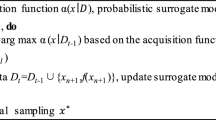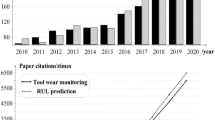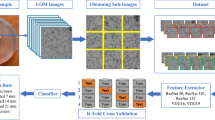Abstract
This paper compares two predictive methodologies for optimizing friction stir welding process and predicting mechanical properties in the welding zone. The first approach combines finite element method (FEM) with artificial neural network (ANN) techniques to forecast hardness variations, reducing reliance on extensive experiments. The second approach integrates ANN and particle swarm optimization (PSO) to predict properties and optimal FSW parameters, particularly emphasizing hardness maximization. Results indicate the superior predictive accuracy of the combined ANN-PSO approach, offering streamlined implementation suitable for practical applications. Indeed, in the FEM-ANN approach, the average error is around 16.50%, while the ANN-PSO approach predicts hardness with an average error of about 4.80%. Moreover, error increases closer to the center line in both approaches, more prominently in the FEM-ANN approach. However, it should be noted that successful implementation of the ANN-PSO model requires a substantial historical dataset for ANN training. On the other hand, the FEM-ANN approach demands relatively less experimental effort but entails longer computational times. Overall, these comparative insights guide the selection of the most suitable approach based on resource availability and project-specific requirements, providing valuable guidance for optimizing FSW process and predicting properties while considering resource constraints.







Similar content being viewed by others
References
Sethi SR, Das A, Baruah M (2021) A review on friction stir welding: a sustainable way of manufacturing. Mater Today Proc. https://doi.org/10.1016/j.matpr.2020.12.682
Mishra RS, Ma ZY (2005) Friction stir welding and processing. Mater Sci Eng R Reports 50:1–78. https://doi.org/10.1016/j.mser.2005.07.001
Khodir SA, Shibayanagi T (2008) Friction stir welding of dissimilar AA2024 and AA7075 aluminum alloys. Mater Sci Eng B Solid-State Mater Adv Technol 148:82–87. https://doi.org/10.1016/j.mseb.2007.09.024
Aissani M, Gachi S, Boubenider F, Benkedda Y (2010) Design and optimization of friction stir welding tool. Mater Manuf Process 25:1199–1205. https://doi.org/10.1080/10426910903536733
Fonda RW, Bingert JF (2004) Microstructural evolution in the heat-affected zone of a friction stir weld. Metall Mater Trans A Phys Metall Mater Sci 35(3):1487–1499. https://doi.org/10.1007/s11661-004-0257-7
Christy JV, Mourad AHI, Sherif MM, Shivamurthy B (2021) Review of recent trends in friction stir welding process of aluminum alloys and aluminum metal matrix composites. Trans Nonferrous Met Soc China English Ed 31:3281–3309. https://doi.org/10.1016/S1003-6326(21)65730-8
Lee WB, Yeon YM, Jung SB (2004) Mechanical properties related to microstructural variation of 6061 Al alloy joints by friction stir welding. Mater Trans 45:1700–1705. https://doi.org/10.2320/matertrans.45.1700
MohammadzadehJamalian H, TamjidiEskandar M, Chamanara A et al (2021) An artificial neural network model for multi-pass tool pin varying FSW of AA5086-H34 plates reinforced with Al2O3 nanoparticles and optimization for tool design insight. CIRP J Manuf Sci Technol 35:69–79. https://doi.org/10.1016/j.cirpj.2021.05.007
Elsheikh AH (2023) Applications of machine learning in friction stir welding: prediction of joint properties, real-time control and tool failure diagnosis. Eng Appl Artif Intell 121:105961
Ulloa N, José Allauca P, Pozo E et al (2023) ANN based fatigue life assessment of FSW on AA2219-T351 and optimization of welding parameter. Mater Today Proc. https://doi.org/10.1016/J.MATPR.2023.05.480
D’Souza AD, Rao SS, Herbert MA (2023) A study of microstructure and mechanical properties of friction stir welded joint of Al-Ce-Si-Mg aluminium alloy plates and optimization cum prediction techniques using Taguchi and ANN. Mater Today Proc. https://doi.org/10.1016/j.matpr.2023.04.125
Guan W, Cui L, Liang H et al (2023) The response of force characteristic to weld-forming process in friction stir welding assisted by machine learning. Int J Mech Sci 253:108409. https://doi.org/10.1016/j.ijmecsci.2023.108409
Sarvaiya J, Singh D (2023) Prediction of performance parameters in friction stir processing using ANN and multiple regression models. Mater Today Proc https://doi.org/10.1016/j.matpr.2023.04.422
Chao YJ, Qi X, Tang W (2003) Heat transfer in friction stir welding—experimental and numerical studies. J Manuf Sci Eng 125:138. https://doi.org/10.1115/1.1537741
Zhang Z, Zhang HW (2008) A fully coupled thermo-mechanical model of friction stir welding. Int J Adv Manuf Technol 37:279–293. https://doi.org/10.1007/s00170-007-0971-6
Colegrove PA, Shercliff HR, Zettler R (2007) Model for predicting heat generation and temperature in friction stir welding from the material properties. Sci Technol Weld Join 12:284–297. https://doi.org/10.1179/174329307x197539
Chen CM, Kovacevic R (2003) Finite element modeling of friction stir welding - thermal and thermomechanical analysis. Int J Mach Tools Manuf 43:1319–1326. https://doi.org/10.1016/S0890-6955(03)00158-5
Akbari M, Aliha MRM, Berto F (2023) Investigating the role of different components of friction stir welding tools on the generated heat and strain ☆. Forces Mech 10:100166. https://doi.org/10.1016/j.finmec.2023.100166
Deepandurai K, Parameshwaran R (2016) Multiresponse optimization of FSW parameters for cast AA7075/SiCp composite. Mater Manuf Process 31:1333–1341. https://doi.org/10.1080/10426914.2015.1117628
Farghaly AA, El-Nikhaily AE, Essa ARS (2019) Prediction of tensile strength of friction stir welded 6061 Al plates. China Weld English Ed 28:1–6. https://doi.org/10.12073/j.cw.20190617001
De Filippis LAC, Serio LM, Facchini F, et al (2016) Prediction of the vickers microhardness and ultimate tensile strength of AA5754 H111 friction stir welding butt joints using artificial neural network. Materials (Basel) 9. https://doi.org/10.3390/ma9110915
Muthu Krishnan M, Maniraj J, Deepak R, Anganan K (2018) Prediction of optimum welding parameters for FSW of aluminium alloys AA6063 and A319 using RSM and ANN. Mater Today Proc 5:716–723. https://doi.org/10.1016/j.matpr.2017.11.138
Ranjith R, Giridharan PK, Senthil KB (2017) Predicting the tensile strength of friction stir welded dissimilar aluminum alloy using ANN. Int J Civ Eng Technol 8:345–353
Shojaeefard MH, Behnagh RA, Akbari M et al (2013) Modelling and pareto optimization of mechanical properties of friction stir welded AA7075/AA5083 butt joints using neural network and particle swarm algorithm. Mater Des 44:190–198. https://doi.org/10.1016/j.matdes.2012.07.025
Sonmez F, Basak H, Baday S (2017) The mechanical strength of aluminum alloys which are joined with friction stir welding modelling with artificial neural networks. 1–4. https://doi.org/10.1109/idap.2017.8090325
Dehabadi VM, Ghorbanpour S, Azimi G (2016) Application of artificial neural network to predict Vickers microhardness of AA6061 friction stir welded sheets. J Cent South Univ 23:2146–2155. https://doi.org/10.1007/s11771-016-3271-1
Maleki E (2015) Artificial neural networks application for modeling of friction stir welding effects on mechanical properties of 7075–T6 aluminum alloy. IOP Conf Ser Mater Sci Eng 103:012034. https://doi.org/10.1088/1757-899X/103/1/012034
Dewan MW, Huggett DJ, Warren Liao T et al (2016) Prediction of tensile strength of friction stir weld joints with adaptive neuro-fuzzy inference system (ANFIS) and neural network. Mater Des 92:288–299. https://doi.org/10.1016/j.matdes.2015.12.005
Quarto M, Bocchi S, D’Urso G, Giardini C (2022) Hybrid finite elements method-artificial neural network approach for hardness prediction of AA6082 friction stir welded joints. Int J Mechatronics Manuf Syst 15:149. https://doi.org/10.1504/ijmms.2022.124919
Quarto M, Bocchi S, D’Urso G, Giardini C (2022) Multiresponse optimization of friction stir welding by an integrated ANN-PSO approach. Proc Inst Mech Eng Part B J Eng Manuf. https://doi.org/10.1177/09544054221138143
Prasad MVRD, Kumar Namala K (2018) Process parameters optimization in friction stir welding by ANOVA. In: Materials Today: Proceedings. Elsevier Ltd, pp 4824–4831. https://doi.org/10.1016/j.matpr.2017.12.057
Threadgill PL, Leonard AJ, Shercliff HR, Withers PJ (2009) Friction stir welding of aluminium alloys. Int Mater Rev 54:49–93. https://doi.org/10.1179/174328009X411136
Alwosheel A, van Cranenburgh S, Chorus CG (2018) Is your dataset big enough? Sample size requirements when using artificial neural networks for discrete choice analysis. J Choice Model 28:167–182. https://doi.org/10.1016/J.JOCM.2018.07.002
Hagan MT, Demuth HB, Beale MH, De Jesus O (2014) Neural network design 2nd edn, Springer
Bocchi S, D’Urso G, Giardini C, Maccarini G (2019) Effects of cooling conditions on microstructure and mechanical properties of friction stir welded butt joints of different aluminum alloys. Appl Sci 9. https://doi.org/10.3390/app9235069
Sorger G, Wang H, Vilaça P, Santos TG (2017) FSW of aluminum AA5754 to steel DX54 with innovative overlap joint. Weld World 61:257–268. https://doi.org/10.1007/s40194-016-0412-y
Author information
Authors and Affiliations
Contributions
All authors contributed to the study conception and design. Material preparation, data collection, and analysis were performed by Sara Bocchi and Claudio Giardini. The first draft of the manuscript was written by Sara Bocchi, and all authors commented on previous versions of the manuscript. All authors read and approved the final manuscript.
Corresponding author
Ethics declarations
Competing interests
The authors declare no competing interests.
Additional information
Publisher's Note
Springer Nature remains neutral with regard to jurisdictional claims in published maps and institutional affiliations.
Rights and permissions
Springer Nature or its licensor (e.g. a society or other partner) holds exclusive rights to this article under a publishing agreement with the author(s) or other rightsholder(s); author self-archiving of the accepted manuscript version of this article is solely governed by the terms of such publishing agreement and applicable law.
About this article
Cite this article
Bocchi, S., Quarto, M., D’Urso, G. et al. A comparative analysis of forecasting surface hardness in various aluminum friction stir welded joints: FEM-ANN hybrid versus ANN-PSO-integrated approaches. Int J Adv Manuf Technol (2024). https://doi.org/10.1007/s00170-024-13770-x
Received:
Accepted:
Published:
DOI: https://doi.org/10.1007/s00170-024-13770-x




